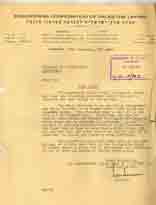Building Technology and Architectural Elements
Rachel Kudish-Vashdi and Yuval Baruch
In accordance with Harrison's guidelines, portions of the building – some of the domes, the stone dressing, and cisterns supplying water to the central pool – were constructed using traditional techniques. But, with the introduction of modern building materials by the local construction industry, and in order to provide a more modern touch and add stability (especially after a major earthquake in 1927), the domes above the vestibule and gallery ceilings were constructed of reinforced concrete. The attention to detail and the excellent quality of material and workmanship make the Rockefeller Museum one of the finest modern constructions in Eretz-Israel.
The Stone – Harrison chose a white building stone (Taltish), which probably originated along the Jericho Road between Jerusalem and Jericho.
Furnishings – All the doors were of fine walnut wood, imported from Turkey, each fitted to the exact dimensions of its arched frame. Metal window frames were produced in England according to Harrison’s plans, as were other metal objects: door handles, locks, catch bars, and lattices. The tall doors of the main entry (weighing about 700 kg) were coated in copper plate ornamented in the decorative style of Islamic North Africa.

mandat archiv. 25 sep, 1935
Floors and Walls – Harrison used two materials for paving the museum interior. In the high-ceilinged galleries where an acoustic solution was needed, Harrison paved the floors with cork to soften the noise of visitors. It is also easier on the feet. In other places, the floors were paved with limestone or polished black mortar. Most of the walls were covered in perlite (rough plaster). But in time, due to problems of building maintenance, some of the walls were covered in smooth plaster, an action that was later seen as a cause of damage to the original plaster.
Lighting – As was the custom in many museums in the first half of the twentieth century, here too, natural light was the main source of illumination. The wide windows set high on the walls protect the exhibits and visitors from direct sunlight. Large glass decorative light fixtures hang only in the vestibule and octagonal galleries.
Additional Articles ...